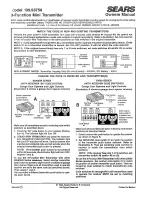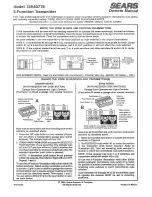
www.sentera.eu
MIW-RTVS1-EN-000 - 03 / 11 / 2020
7 - 12
indicates alarms. It is used for connecting an alarm indication device - e.g.
a lamp, buzzer, etc.
4.4
Connect the TK contacts for monitoring of the thermal motor protection to
the motor TK terminals.
A safety isolator / disconnect switch should be installed on the mains electricity
side of all motor drives.
ATTENTION
Fig. 3 Wiring and connections
RJ45 master socket - to
connect Sentera HVAC
transmitter or potentiometer
RJ45 gateway - to connect PC
with 3SModbus software
Regulated output to
motor 230 VAC
Unregulated output 230 VAC
Power supply
(230 VAC / 50—60 Hz)
TK monitoring for thermal
motor protection
Make sure the connections are correct before you power the unit.
ATTENTION
5.
Close the cover and secure it with the screws.
6.
Tighten the cable glands.
7.
Switch on the mains supply.
8.
Customise the factory settings to the desired ones via the 3SModbus software
or Sensistant. For the default factory setting, see the
Modbus register map.
The
desired fan speed can be adjusted via Modbus holding register 14.
For the complete Modbus register data, refer to the product Modbus Register Map,
which is a separate document attached to the article code on the website and
contains the registers list.
NOTE
Optional settings
1.
In automatic mode, a Sentera potentiometer with Modbus RTU communication
can be connected to RTVS1. To obtain demand based fan speed control, RTVS1
can be combined with a Sentera HVAC sensor. The combination of RTVS1
with a Sentera HVAC transmitter allows you to control fan speed in function
of temperature, relative humidity, carbon dioxide, air quality (TVOC) or carbon
monoxide. The controlled parameter can be selected in RTVS1 Modbus holding
register 20.
Crimp the RJ45 cable for the Modbus Master connector and plug it into the
socket. It is used to connect RTVS1 to a Sentera transmitter, intelligent sensor
or sensor controller. Consult our website for compatible devices
.
TRANSFORMER FAN SPEED CONTROLLER WITH
MODBUS RTU COMMUNICATION
RTVS1






























